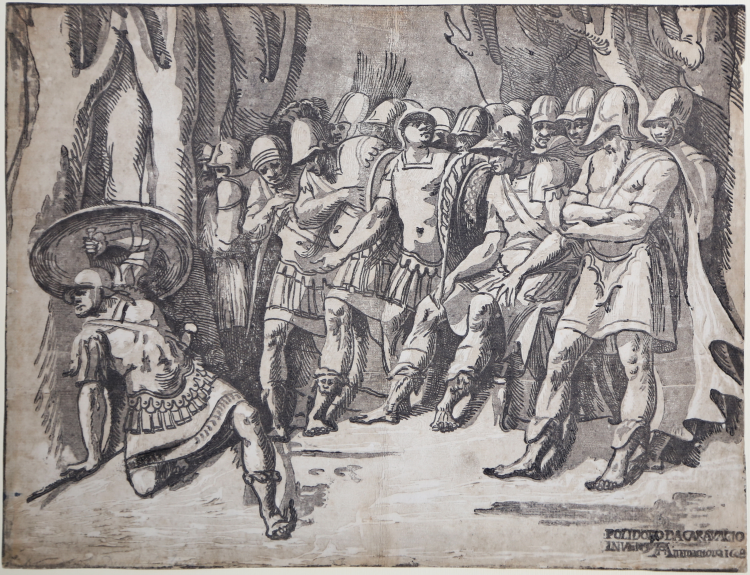




| Reference: | S32028 |
| Author | Niccolò ROSSIGLIANI detto "Il Vicentino" |
| Year: | 1540 ca. |
| Measures: | 411 x 315 mm |



| Reference: | S32028 |
| Author | Niccolò ROSSIGLIANI detto "Il Vicentino" |
| Year: | 1540 ca. |
| Measures: | 411 x 315 mm |
Chiaroscuro woodcut from three blocks in green, grey and black. Inscribed with inventor's name, publisher's address and date lower left: 'POLIDORO DA CARAVAGIO/INVENT AA in mantoua [160]8'.
After Polidoro da Caravaggio.
Example of the second state of two, with Andreani’s address added at lower right.
Magnificent proof, printed on contemporary laid paper with watermark "crossbow in circle with star" irregularly trimmed at marginal line, in excellent condition.
Presumably, the composition is based on one of the numerous “all’antica” composiitions with which Polidoro da Caravaggio ornated the facades of Roman palaces, the majority of which have vanished.
The scene depicted was interpreted as The death of Ajax. When Achilles was killed, his armor was to be awarded to the next greatest Greek hero. The armor led to a dispute between Ajax and Odysseus. Both heroes felt entitled to it. To settle the matter, the Greeks decided to take a vote, and they awarded the armor to Odysseus.
Enraged by this decision, Ajax planned an assault on the Greek troops that night. However, Athena, the goddess of wisdom, drove Ajax temporarily insane, and he attacked a flock of sheep instead. After recovering his senses, he was so ashamed that he killed himself with the sword Hector had given him
Vicentino’s print illustrates dying hero to left leaning against tree, with the left raised with shield; right leg bent beneath him; behind to right group of Greek warriors; King Menelaus seated and Agamemnon in foreground.
According Barryte, perhaps this is the moment after the fate of the armor is decided and the figure standing to the right, arms crossed and head down is Odysseus - not Agamemnon -, unwilling to boast of his success as Ajax falls the ground, writhing in bitter disappointment and unwilling to face those by whom he felt wronged.
Bibliografia
Bartsch A., Le peintre graveur, Vienna, 1803-1821, v. XII, p. 96, n. 5; Le Blanc IV.116.7; Oberhuber, K., Gnann, A., 'Roma e lo stile classico di Raffaello (1515-1527)', cat. n. 220; B. Barryte, Myth, Allegory and Faith. The Kirk Edward Long Collection of Mannerist Prints, Cinisello Balsamo, 2015, n. 104; Takahatake N., Atlante delle xilografie italiane del Rinascimento, ALU.0989.1.
Niccolò ROSSIGLIANI detto "Il Vicentino" (Attivo a Vicenza 1540-50)
|
Italian woodcutter and printer. He signed five chiaroscuro woodcuts, each after a different artist and all undated. Probably the earliest is a two-block woodcut of Hercules and the Lion after Giulio Romano. Cloelia after Maturino or Giulio Romano, in three blocks, is still rather crudely cut and registered, and probably the next chronologically. A very cursive, elegant line manifests itself in subsequent works, such as Ajax and Agamemnon after Polidoro da Caravaggio, the Sacra Conversazione with St Catherine after a design attributed to Camillo Boccaccino and Christ Healing the Lepers after Parmigianino. An unsigned Adoration of the Magi and The Cardinal and the Doctor can also reasonably be ascribed to him. His hand is doubtless one of several discernible in a large group of anonymous chiaroscuros based on designs by Parmigianino that may represent the products of a workshop supervised by Vicentino. Vasari related how Parmigianino had certain chiaroscuros cut by Antonio da Trento, and that many other designs were printed after the painter’s death by ‘Joannicolo Vicentino’. A group of ten small anonymous two-block chiaroscuros after silverpoint drawings by Parmigianino as well as the Twelve Apostles in which two cutting hands are visible, are presumably part of this output, along with about a dozen more anonymous chiaroscuros. That Vicentino had a workshop is further suggested by the fact that a large number of the Parmigianino drawings related to the chiaroscuros remained together and that Andrea Andreani seems to have acquired many of the blocks and reprinted them later in the 16th century.
|
Niccolò ROSSIGLIANI detto "Il Vicentino" (Attivo a Vicenza 1540-50)
|
Italian woodcutter and printer. He signed five chiaroscuro woodcuts, each after a different artist and all undated. Probably the earliest is a two-block woodcut of Hercules and the Lion after Giulio Romano. Cloelia after Maturino or Giulio Romano, in three blocks, is still rather crudely cut and registered, and probably the next chronologically. A very cursive, elegant line manifests itself in subsequent works, such as Ajax and Agamemnon after Polidoro da Caravaggio, the Sacra Conversazione with St Catherine after a design attributed to Camillo Boccaccino and Christ Healing the Lepers after Parmigianino. An unsigned Adoration of the Magi and The Cardinal and the Doctor can also reasonably be ascribed to him. His hand is doubtless one of several discernible in a large group of anonymous chiaroscuros based on designs by Parmigianino that may represent the products of a workshop supervised by Vicentino. Vasari related how Parmigianino had certain chiaroscuros cut by Antonio da Trento, and that many other designs were printed after the painter’s death by ‘Joannicolo Vicentino’. A group of ten small anonymous two-block chiaroscuros after silverpoint drawings by Parmigianino as well as the Twelve Apostles in which two cutting hands are visible, are presumably part of this output, along with about a dozen more anonymous chiaroscuros. That Vicentino had a workshop is further suggested by the fact that a large number of the Parmigianino drawings related to the chiaroscuros remained together and that Andrea Andreani seems to have acquired many of the blocks and reprinted them later in the 16th century.
|